|
Progressive Men of
Minnesota
Minneapolis Journal
1897
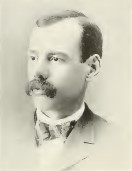 ISAIAH HENRY BRADFORD is a
banker of Hubbard, Hubbard County, Minnesota.
Mr. Bradford has the satisfaction of tracing his
ancestral hue back to the famous Plymouth
colony, he being a direct descendant of Governor
Bradford. His ancestry was also prominent in the
Revolutionary War and the War of 1812. James
Bradford, his father, was born in Gushing,
Maine, September 21, 1805, and he emigrated to
Wisconsin when a young man, settling at Monroe.
After living in several localities in Wisconsin,
he moved to Iowa in 1864, establishing himself
at Nashua and engaging in the business of wagon
manufacturing. His wife was Miss Sarah Hudson,
who is a native of Sardinia, New York. She is a
descendant of Henry Hudson. Her family was for
many years prominent in Rhode Island. She is
still living with a daughter at Hubbard. Her
husband died at Nashua on July 13, 1877. ISAIAH HENRY BRADFORD is a
banker of Hubbard, Hubbard County, Minnesota.
Mr. Bradford has the satisfaction of tracing his
ancestral hue back to the famous Plymouth
colony, he being a direct descendant of Governor
Bradford. His ancestry was also prominent in the
Revolutionary War and the War of 1812. James
Bradford, his father, was born in Gushing,
Maine, September 21, 1805, and he emigrated to
Wisconsin when a young man, settling at Monroe.
After living in several localities in Wisconsin,
he moved to Iowa in 1864, establishing himself
at Nashua and engaging in the business of wagon
manufacturing. His wife was Miss Sarah Hudson,
who is a native of Sardinia, New York. She is a
descendant of Henry Hudson. Her family was for
many years prominent in Rhode Island. She is
still living with a daughter at Hubbard. Her
husband died at Nashua on July 13, 1877.
I.
H. Bradford was born on June 5, 1857, in the
town of Washington, Green County, Wisconsin. His
early education commenced in the public schools
of Milford, Wisconsin. When the
family moved to Iowa he entered the public
schools of Nashua and made rapid progress in his
studies. In 1874 he graduated with honors from
the Nashua High school and then entered the
Upper Iowa University at Fayette, as a student
in the commercial and college courses. From this
department he graduated on January 18, 1876, at
the head of the class. On March 28, 1876, he was
offered a position of cashier of the banking
house of the Hon. A. J. Felt, of Nashua. This
position he at once accepted. He was the
youngest cashier at that time in the United
States, who had full charge and management of
the bank.
Mr. Bradford continued in charge of this
banking house until it closed out its affairs by
sale in 1878, to the First National Bank of
Nashua.
He was then employed by the First
National Bank in making out a set of abstract
books for Chickasaw County.
A
short time afterwards he associated himself with
Moses Stewart, Jr., of Nashua, in organizing the
Bank of Verndale, in Wadena County, Minnesota.
This was in October, 1880. Mr. Bradford became
cashier of the new bank and continued in that
position for two years when he resigned and
joined Isaac Hazlett and E. S. Case in
organizing the Wadena County Bank of Verndale.
He was cashier of this institution until 1883.
In December, 1885, he accepted the position of
cashier and manager of the banking house of
James Billings, of Hubbard, and continued in
this position for six years when the bank was
sold to other parties. Besides managing Mr.
Billings’ interests, Mr. Bradford had the
general superintending of a large farm, loan and
land business and of a large flouring mill at
Hubbard. Under his management the volume of
banking business increased to over three million
dollars. He now carries on a banking business at
Hubbard on his own account. He has a large
eastern clientage and is engaged in placing
loans on western securities. He is the local
land agent for the Northern Pacific Railroad,
and during the last sixteen years has placed
over three hundred settlers and sold about six
thousand acres of railroad lands. He has been
instrumental in bringing thousands of dollars in
capital into his section of the state for
investment, as well as inducing a large number
of settlers to locate in Hubbard County as their
place of residence. Mr. Bradford was one of the
promoters and incorporators of the Duluth &
Great Western Railroad Company. He is treasurer
of the corporation, and is now laboring hard
with eastern capitalists for the success of the
enterprise.
In politics he is a staunch
republican, and during the campaign of 1896 an
advocate of sound money. He is a member of the
Methodist Episcopal Church, in which he has held
various offices. Though not an office seeker, he
was first Clerk of Courts of Hubbard County and
has been influential in the county politics. In
September, 1882, Mr. Bradford was married to
Miss Christina A. Bolton, of Verndale,
Minnesota, daughter of the late George Bolton.
They have had three children, George Miles,
Dilla Carrie, who died on September 1, 1893, and
Wealthy.
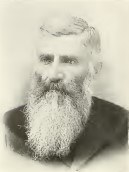 JOHN SCHOCK HUNTSINGER
register of deeds of Hubbard County, Minnesota,
is a native of Indiana. His father,
Joseph Huntsinger, was a farmer of Wayne County,
Indiana, who combined with his occupation as a
farmer, a thorough knowledge of the carpenter’s
and joiner’s trade. By descent a German, he
inherited the thrifty characteristics of that
race, and with the aid of his wife, who was also
of German origin, though born in Pennsylvania,
he became independent. JOHN SCHOCK HUNTSINGER
register of deeds of Hubbard County, Minnesota,
is a native of Indiana. His father,
Joseph Huntsinger, was a farmer of Wayne County,
Indiana, who combined with his occupation as a
farmer, a thorough knowledge of the carpenter’s
and joiner’s trade. By descent a German, he
inherited the thrifty characteristics of that
race, and with the aid of his wife, who was also
of German origin, though born in Pennsylvania,
he became independent.
The
education of his son John was obtained, as was
that of many of the boys of the early times, in
the log school house and from books borrowed or
bought and read during the long winter evenings
before the open fire. John never went to college
but, fitting himself as well as he could,
commenced at last to study medicine under the
direction of Dr. John Ulrich Frietzsche. He
commenced to practice medicine in Noblesville,
Indiana. In 1856 he moved to Greenfield,
Indiana, and after practicing there for four
years he set up again in Cambridge, Wayne
County, where he continued to practice until he
entered the army.
Enlisting
in 1862, Mr.
Huntsinger rendered valuable aid in the
organization of the Twenty-second Indiana
Battery.
In July, 1863 he assisted in organizing
the Colvin’s Battery, Illinois Light Artillery,
and served with this noted battery during the
remainder of the war. He commenced as an orderly
sergeant. In December, 1863, he was promoted to
the post of second lieutenant and a year later
to first lieutenant. When the battery went into
service it was ordered across the Cumberland
Mountains to join Burnside’s Corps, then
investing Knoxville. They had the honor of
assisting in the capture of that place and were
then ordered east into Virginia. On this raid
through the mountains of East Tennessee the
company had the usual experiences of soldiers on
a raid in the heart of the enemy’s country. Several
months elapsed before the division returned to
Knoxville. They had done some hard fighting and
were classed as veterans. They rejoined Burnside
in January, 1864, and fought under that famous
general and Generals Sturgis and Shackford
during the remainder of the war, participating
in the lively campaigns of the western army.
Captain Huntsinger was finally mustered out in
July, 1865.
He
has, of course, retained his interest in the
affairs of the veterans, and is a prominent
member of E. S. Frazier Post, No. 147, G. A. R.,
of Park Rapids, Minnesota. Mr.
Huntsinger settled in Park Rapids in June, 1882.
He erected the Colvin House, which he conducted
successfully for some time. He took an active
part in politics, and during his residence in
Park Rapids has been frequently called to serve
the public in positions of trust. He was town
clerk for four years, was deputy clerk of court
from 1884 to 1887. and court commissioner from
1886 to 1894. In the year 1886 he was elected
register of deeds and has held that office ever
since, being again re-elected at the last
election.
During this period he has been prominent
in the local councils of the Democratic party,
to which he belongs, and has several times
represented the county in state conventions. He
is also a prominent Odd Fellow. In 1852 Mr.
Huntsinger was
married to Miss Martha I. Galbraith, who was a
native of the same county in Indiana in which he
himself was born. They have four children, Josie
Near, who lives at Park Rapids; Nancy M.
Addison, living at Greenfield, Indiana: Bell
Downer, living at Osage, Minnesota, and Alice C.
Horton, whose husband is clerk of the district
court at Park Rapids.
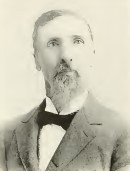 GILBERT H. RICE By inheritance and
personal experience G. H. Rice,
the first settler of Park Rapids, Minnesota,
seems to have been fitted for pioneer life. His
father, Benjamin Rice, was a native of St.
Lawrence County, New York. He served as a
private soldier in the war of 1812, receiving an
honorable discharge at the end of that
conflict.
In 1816 he married Miss Mary Malty, and
took his young wife to Chautauqua County, New
York, which at that time was a dense
wilderness. Mr. Rice made
a clearing, building himself a home and became a
prosperous farmer. Mr. and Mrs. Rice had five
children. Gilbert was born in Chautauqua County
on March 13, 1838. When he was fourteen years of
age, on May 11, 1852, his father died. GILBERT H. RICE By inheritance and
personal experience G. H. Rice,
the first settler of Park Rapids, Minnesota,
seems to have been fitted for pioneer life. His
father, Benjamin Rice, was a native of St.
Lawrence County, New York. He served as a
private soldier in the war of 1812, receiving an
honorable discharge at the end of that
conflict.
In 1816 he married Miss Mary Malty, and
took his young wife to Chautauqua County, New
York, which at that time was a dense
wilderness. Mr. Rice made
a clearing, building himself a home and became a
prosperous farmer. Mr. and Mrs. Rice had five
children. Gilbert was born in Chautauqua County
on March 13, 1838. When he was fourteen years of
age, on May 11, 1852, his father died.
Three years later Mrs. Rice, with her
children removed to Mitchell County, Iowa,
replacing the pioneer life of the forests of New
York for a lonesome home on the unbroken
prairies of Iowa. At the time they settled in
Mitchell County there was not a mile of railroad
in the state and their post office was fifty
miles away. Gilbert received a fair common
school education, and in December 1861 he
enrolled his name as the first student in the
Cedar Valley Seminary at Osage, Iowa, in fact
the young man had the honor of naming the
institution. After
attending this school for one year he entered
the milling business with his brothers at
Riceville, Iowa, the town which sprung up after
their settlement in Mitchell County took its
name from the family. In 1857 he laid out the
town site and made the first substantial
improvement. The land used
was the homestead originally taken up by his
mother, and which she received from the
government for her husband’s services during the
war of 1812.
In 1866 Mr. Rice
bought out the interests of his brothers,
F.
C. and Dennis, in the milling business at
Riceville and sold a half interest in the whole
business to Nelson Pierce. A year later he sold
the remaining half interest in the business to
Mr.
Pierce and again entered into partnership
with his brothers, building a flour mill at
Osage, Iowa. In 1875 he
bought out his brothers’ interest again and
continued the business alone until 1881.
It was, perhaps, the spirit of the
pioneer that induced Mr. Rice to again seek out
the forestry. When he
came to the present location of Park Rapids in
June, 1881, his home was fifty miles from any
railroad or post office, and their life for a
few years was thoroughly that of a pioneer, as
had been his mother’s experiences in New York
and Iowa. He built a saw and flour mill on the
lands which were, in 1883, laid out as the town
site. The town was given the name of Park
Rapids, and it has become one of the most
thriving of the younger towns of the state.
Mr.
Rice has been thoroughly identified with
its prosperity. He has been
continually in the milling business for
thirty-six years, and has been uniformly
successful. Mr. Rice volunteered for the service
in the Federal army in 1863, but the quota being
full he was not received. He was commissioned as
first lieutenant in the Iowa militia, and helped
to organize a company of one hundred men to
fight the Indians in Minnesota at the time of
the Sioux out-break, but the governor of
Minnesota, however, refused to accept any troops
outside his own state.
In politics Mr. Rice has always been a
Republican. He has never sought office, but in
1884 was induced to accept the nomination for
probate judge: was elected and served his first
term in Hubbard County. He belongs to the Sound
Money Club of Park Rapids. He is a
member of the I. O. O. F. Shelf Prairie Lodge,
No. 131, at Park Rapids.
His church membership is with the first
Baptist church of his town. On September 17,
1866, Mr.
Rice married Miss Martha Pierce. They have
had four children; Edith E., Leonard H., Arthur
L. and Ethel L. Edith E. Rice was married on
August 9, 1888, to F. A. Vanderpoel, of Park
Rapids. Leonard was married on August 16,
1890, to Miss Cora I.
Rima.
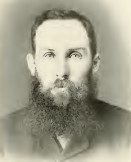 ENOS MILO RICKER The
frontier journalist is a product of
circumstances. An
example of the evolution of one of the newspaper
men of this class is found in the career of Enos
M. Ricker, editor of the Hubbard County
Enterprise, of Park Rapids, Minnesota. Against many
odds and through all sorts of difficulties Mr.
Ricker has struggled to that most onerous but at
the same time most independent position the
editorship of a good country newspaper. ENOS MILO RICKER The
frontier journalist is a product of
circumstances. An
example of the evolution of one of the newspaper
men of this class is found in the career of Enos
M. Ricker, editor of the Hubbard County
Enterprise, of Park Rapids, Minnesota. Against many
odds and through all sorts of difficulties Mr.
Ricker has struggled to that most onerous but at
the same time most independent position the
editorship of a good country newspaper.
In
Mr. Ricker’s case it was an instance of Yankee
shrewdness united with Western enterprise and
persistency. His father, Hazen Ricker, was a
native of Vermont. He learned the shoemaker’s
trade, and after working at it for several
years, came West and settled on a farm in Howard
County, Iowa. This was in 1856. Mr. Ricker
had, before leaving New England, united his
fortunes with those of a New Hampshire girl Miss
Elizabeth I. Cutting. They were used to the hard
work of New England homesteads, and when they
emigrated to the prairies of Iowa and commenced
the new kind of life they brought with them, and
instilled into the minds of their children the
idea that success comes with persistent
endeavor. Mrs. Ricker was a lineal descendant of
Mary Townley, of England, a niece of the Duke of
Wellington, who married a man beneath her in the
social scale, and came to America in early days.
Young
Enos was born on the farm in Iowa, four miles
east of the village of Riceville. From childhood
he was inured to work, passing through the
various classes of farm work assigned to a lad,
later finding a job in a meat market, carrying
mail on a stage line, clerking in a store at
Riceville and the post office at the same place.
He served about three years’ apprenticeship in a
harness shop at Riceville ; but he found that he
was not destined to be a harnessmaker. When
about sixteen years of age he bought a small
card printing press and a font of type, and at
odd times printed cards and small jobs. This
proved to his taste, and as time went on he
added to his little office, gradually
accumulating type and from time to time changing
for a larger press, until he had a fair outfit
and had gained a knowledge of the printing
trade. All this time he was working at one or
the other of the employments before referred to.
In the meantime his father had removed to Park
Rapids, Minnesota.
In
1885 Enos went to Minnesota and remained for two
years, but in 1887 returned to Riceville and
bought the Riceville Recorder. He
remained as editor and publisher of the paper
until 1890, when he decided to become
permanently a citizen of Minnesota, and moved to
Park Rapids, where he took up land under the
homestead law. A year later he leased the
Hubbard Bulletin. published in the village of
Hubbard, and published it for eleven months. On
July 1, 1892, in company with A. W. Page, he
bought the Hubbard County Enterprise. Later he
became sole proprietor. But after a time took in
W.
S. Eoster as
partner. This partnership was dissolved in
April, 1895, and shortly afterwards the firm of
Davis & Taber became publishers of the
paper, Mr. Ricker remaining as editor and
business manager. In 1889 Mr. Ricker was married
to Miss Cora M. Suavely, of Indiana. They have
two children, Elsie and Bell. Mr. Ricker has
been since boyhood a member of the
Congregational
church.
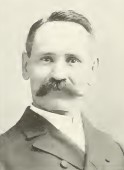 FLORANCE A. VANDERPOEL of
Park Rapids, is a native of Wisconsin. He comes
of old Revolutionary stock, as his great
grandfather was one of the members of the
celebrated Boston Tea Party. Abraham
Vanderpoel, son of the hero of Boston harbor,
was born in the state of New York, and moved to
Wisconsin in the early days, settling with his
young wife in Jefferson County. He was a member
of the convention held to form a constitution
for the young state, which convened at Madison
on December 15, 1847, and he took an active part
in the construction of the important document.
In 1861 he enlisted as captain of Company E,
Twelfth Wisconsin Volunteer Infantry, and served
with honor until compelled to leave the army on
account of sickness. He died in 1870. His son,
Clarence C. Vanderpoel, enlisted in the same
company at the breaking out of the war, but was
afterwards transferred to the commissary
department, with headquarters at Natchez,
Mississippi, where he remained until the close
of the war. He then moved to West Mitchell,
Iowa, where he still lives. He owns and operates
the Paragon Woolen Mills at West Mitchell, and
also has under cultivation about five hundred
acres of land near Blooming Prairie, Minnesota.
He was a member of the house in the Iowa
legislature in 1884, and took part in securing
the passage of the prohibition law, which
remained in force until 1894. His wife, who was
Miss Emily A. Squire, has been very active of
late years in temperance and church work. FLORANCE A. VANDERPOEL of
Park Rapids, is a native of Wisconsin. He comes
of old Revolutionary stock, as his great
grandfather was one of the members of the
celebrated Boston Tea Party. Abraham
Vanderpoel, son of the hero of Boston harbor,
was born in the state of New York, and moved to
Wisconsin in the early days, settling with his
young wife in Jefferson County. He was a member
of the convention held to form a constitution
for the young state, which convened at Madison
on December 15, 1847, and he took an active part
in the construction of the important document.
In 1861 he enlisted as captain of Company E,
Twelfth Wisconsin Volunteer Infantry, and served
with honor until compelled to leave the army on
account of sickness. He died in 1870. His son,
Clarence C. Vanderpoel, enlisted in the same
company at the breaking out of the war, but was
afterwards transferred to the commissary
department, with headquarters at Natchez,
Mississippi, where he remained until the close
of the war. He then moved to West Mitchell,
Iowa, where he still lives. He owns and operates
the Paragon Woolen Mills at West Mitchell, and
also has under cultivation about five hundred
acres of land near Blooming Prairie, Minnesota.
He was a member of the house in the Iowa
legislature in 1884, and took part in securing
the passage of the prohibition law, which
remained in force until 1894. His wife, who was
Miss Emily A. Squire, has been very active of
late years in temperance and church work.
Their
son Florance, was born at Newport, Sauk County,
Wisconsin, on August 13, 1856. He attended the
public schools at Newport and West Mitchell
until January, 1875, when he entered the
preparatory department of the State University
of Iowa, from which institution he graduated
with honor in 1880. From his class of forty-five
he was chosen as one of the fifteen speakers on
commencement day. While at college Mr.
Vanderpoel was the plaintiff in the famous
election case which was carried to the supreme
court of Iowa to test the right of students to
vote at elections while attending college. The
case was entitled F. A. Vanderpoel vs. James
O’Hanlon, et al. Judgment
was awarded the plaintiff in the district court
against the judges of election for refusing to
receive his vote, but on an appeal the judgment
was overruled, it being decided that a student
at college, without any intentions as to his
residence after graduation, was not a legal
voter at the place where he was studying. This
decision was rendered in 1880.
In
June, 1883, Mr. Vanderpoel graduated from the
law department of the Iowa University, receiving
the degree of LL. B. During the following winter
he was clerk of the judiciary committee of the
house of representatives of the Iowa
legislature. In the fall of 1883 he formed a law
partnership with the Hon. J. F. Clyde, as Clyde
& Vanderpoel, and commenced practice at
Osage, Iowa.
In
January, 1885, he came to Minnesota and located
at Park Rapids, then fifty miles from the
nearest railroad. Since he took up his residence
at Park Rapids he has served as deputy county
treasurer and deputy county auditor, and in 1887
and 1888 was county attorney. In the fall of the
latter year he was elected county auditor. After
serving one term he resumed practice, and has
since devoted his time exclusively to the law.
Mr. Vanderpoel has always been a Republican in
politics. He owns membership in three secret
societies—the Odd Fellows, Knights of Pythias
and Modern Woodmen.
In
1891 he joined the Baptist church and was the
first person ever baptized in Lake Itasca, the
headwaters of the Mississippi river. On the
ninth day of August, 1888, Mr. Vanderpoel and
Miss Edith E. Rice, daughter of Gilbert H Rice, were
married at Park Rapids. They have had two
daughters, one of whom. Lucille F., born
September 10, 1889, is now
living.
 PLYMPTON AYERS WALLING is
a prominent physician of Hubbard County, and one
of many examples of the self-made, successful
Western man. His early life was surrounded by
conditions which would have discouraged a boy
not possessed of an unusual amount of pluck and
determination. Born on
a Pennsylvania farm—Columbus, Warren County—his
father, Asaph Walling, always a poor man, young
Plympton found his boyhood anything but easy.
Even the school facilities of the region were
scarcely up to the frontier grade, until he was
nine years old Plympton had not sat at a school
desk. His school seat was on a bass wood
puncheon set against the wall of a log school
house. Later on he attended better schools, but
necessarily in an intermittent way which
interfered with complete courses of study. Much of
his education was obtained at home. He was
determined to have an education and he secured
it; but by force of circumstances was unable to
graduate from any institution which he attended. PLYMPTON AYERS WALLING is
a prominent physician of Hubbard County, and one
of many examples of the self-made, successful
Western man. His early life was surrounded by
conditions which would have discouraged a boy
not possessed of an unusual amount of pluck and
determination. Born on
a Pennsylvania farm—Columbus, Warren County—his
father, Asaph Walling, always a poor man, young
Plympton found his boyhood anything but easy.
Even the school facilities of the region were
scarcely up to the frontier grade, until he was
nine years old Plympton had not sat at a school
desk. His school seat was on a bass wood
puncheon set against the wall of a log school
house. Later on he attended better schools, but
necessarily in an intermittent way which
interfered with complete courses of study. Much of
his education was obtained at home. He was
determined to have an education and he secured
it; but by force of circumstances was unable to
graduate from any institution which he attended.
After
a term or so at the Northwestern Normal School
of Edinburgh, Pennsylvania, he entered the
medical department of the University of Buffalo,
from which he graduated on February 23, 1876.
Thus, at the age of twenty-six, Mr. Walling
found himself equipped for the practice of his
chosen profession. It had been a hard struggle,
but it had fitted him for the exacting and
trying life of a physician. He had taught school
and “boarded ‘round,” worked at anything and
everything which would support life and furnish
funds for his education. But, though he stepped
out of the medical college without a dollar, he
had learned the lessons of self-reliance,
independence, industry and confidence which lie
at the foundations of success.
When
Dr. Walling came to Minnesota and settled in
Park Rapids, in May, 1882, there were not fifty
people in that village. All the discouragements
of pioneer life confronted him. Roads, business,
houses, railroads, mails and even people were
wanting. But Dr. Walling had cast his lot with
the young village and he stayed—stayed to see a
thriving town grow up surrounded by fine farms,
with good railroad facilities and excellent
prospects for the future. It has
been his fortune to see public opinion regarding
the northern part of the state change from an
attitude of skepticism regarding its value to
one of open interest and appreciation. The few
pioneers who had courage to stake their success
on the excellence of the soil of northern
Minnesota are now reaping their reward.
Dr. Walling
went in for a country practice and has secured
it—and the best of its kind. He has built a
pleasant home in Park Rapids, been honored by
two elections to the position of coroner, and
has held since 1883 the office of secretary of
the United States Board of Examining
surgeons.
He is a member of the Minnesota State
Medical Society and of the American Medical
Association, and is an occasional contributor to
medical magazines and to the literature of the
societies. On August 11, 1875, Dr. Walling and
Mrs. Rosaline E. Knowles were married at Corry,
Pennsylvania. They have three children. The
eldest, Jason Marion, is now eighteen, and is
studying at Pillsbury Academy. He intends to
practice medicine. Iva Ellen, aged fifteen, and
Ivan Elmer, aged eleven, are at home with their
parents.
The information
on Trails to the Past © Copyright
may be used in personal family history research, with source citation. The pages in entirety may not be duplicated for publication in any fashion without the permission of the owner. Commercial use of any material on this site is not permitted. Please respect the wishes of those who have contributed their time and efforts to make this free site possible.~Thank you!
|
|
|
|
|
|
|



